Hydrodynamic Model of the Area of the Żelazny Most Mining Waste Storage Facility to Reconstruct the Migration of Saline Groundwater
Abstract
:1. Introduction
2. Material and Methods
2.1. Study Area and the MWSF Characteristics
2.2. Data Preparation
2.3. Assessment of the Hydraulic Conductivity of Tailings Using the MRS Method
2.4. Model Schematization
3. Results and Discussion
3.1. Model Grid
3.2. Model Structure and Boundary Conditions
3.3. Hydraulic Conductivity of Tailings
3.4. Model Calibration and Verification
3.5. Hydrodynamic Forecasts on the Model
4. Conclusions
Author Contributions
Funding
Data Availability Statement
Acknowledgments
Conflicts of Interest
References
- Cacciuttolo, C.; Atencio, E. Past, Present, and Future of Copper Mine Tailings Governance in Chile (1905–2022): A Review in One of the Leading Mining Countries in the World. Int. J. Environ. Res. Public Health 2022, 19, 13060. [Google Scholar] [CrossRef] [PubMed]
- Wu, D. Solutions for Surface Disposal of Mine Tailings BT—Mine Waste Management in China: Recent Development; Wu, D., Ed.; Springer: Singapore, 2020; ISBN 978-981-32-9216-1. [Google Scholar]
- Cacciuttolo, C.; Tabra, K. Water Management in the Closure of Tailings Storage Facilities. In Proceedings of the 10th International Conference on Acid Rock Drainage and IMWA Conference, Santiago, Chile, 12 April 2015. [Google Scholar]
- East, D.; Fernandez, R. Managing Water to Minimize Risk in Tailings Storage Facility Design, Construction, and Operation. Mine Water Environ. 2021, 40, 36–41. [Google Scholar] [CrossRef]
- Franks, D.M.; Boger, D.V.; Côte, C.M.; Mulligan, D.R. Sustainable development principles for the disposal of mining and mineral processing wastes. Resour. Policy 2011, 36, 114–122. [Google Scholar] [CrossRef]
- Schoenberger, E. Environmentally sustainable mining: The case of tailings storage facilities. Resour. Policy 2016, 49, 119–128. [Google Scholar] [CrossRef]
- Kossoff, D.; Dubbin, W.; Alfredsson, M.; Edwards, S.; Macklin, M.; Hudson-Edwards, K.A. Mine tailings dams: Characteristics, failure, environmental impacts, and remediation. J. Appl. Geochem. 2014, 51, 229–245. [Google Scholar] [CrossRef]
- Echeverry-Vargas, L.; Ocampo-Carmona, L.M. Recovery of Rare Earth Elements from Mining Tailings: A Case Study for Generating Wealth from Waste. Minerals 2022, 12, 948. [Google Scholar] [CrossRef]
- Jouini, M.; Royer-Lavallée, A.; Pabst, T.; Chung, E.; Kim, R.; Cheong, Y.-W.; Neculita, C.M. Sustainable Production of Rare Earth Elements from Mine Waste and Geoethics. Minerals 2022, 12, 809. [Google Scholar] [CrossRef]
- Ringle Raja, S.; Balamurali, K.; Eunice, S. Evaluating groundwater contamination: An examination of a municipal solid waste dump yard in southern India’s Manchester City. Resour. Conserv. Recycl. Adv. 2023, 20, 200196. [Google Scholar] [CrossRef]
- Han, D.; Tong, X.; Currell, M.; Cao, G.; Jin, M.; Tong, C. Evaluation of the impact of an uncontrolled landfill on surrounding groundwater quality, Zhoukou, China. J. Geochem. Explor. 2014, 136, 24–39. [Google Scholar] [CrossRef]
- Mahdi, A.; Shakibaeinia, A.; Dibike, Y.B. Numerical modelling of oil-sands tailings dam breach runout and overland flow. Sci. Total Environ. 2020, 703, 134568. [Google Scholar] [CrossRef]
- Wang, K.; Yang, P.; Yu, G.; Yang, C.; Zhu, L. 3D Numerical Modelling of Tailings Dam Breach Run Out Flow over Complex Terrain: A Multidisciplinary Procedure. Water 2020, 12, 2538. [Google Scholar] [CrossRef]
- Palmer, J. Simulation of Tailings Filtration Performance. In Proceedings of the 23rd International Conference on Paste, Thickened and Filtered Tailings; Quelopana, H., Ed.; Gecamin Publications: Santiago, Chile, 2020. [Google Scholar] [CrossRef]
- Do, T.M.; Laue, J.; Mattsson, H.; Jia, Q. Numerical Analysis of an Upstream Tailings Dam Subjected to Pond Filling Rates. Appl. Sci. 2021, 11, 6044. [Google Scholar] [CrossRef]
- Ubechu, B.O.; Opara, A.I.; Onyekuru, S.O.; Ikechukwu, C.C.; Ofoh, I.J.; Okechukwu, S.I.; Nwokeabia, C.N.; Iwuoha, P.O.; Ajaegbu, E.E. Hydrogeological assessment and contaminant transport modelling of Enyimba landfill site in Aba, Nigeria. Water Pract. Technol. 2024, 19, 2108–2124. [Google Scholar] [CrossRef]
- Juanting, N.; Litang, H.; Menglin, Z. Transport of ammonia nitrogen for groundwater pollution control in an informal low-permeability landfill site. Hydrol. Res. 2022, 53, 370–384. [Google Scholar] [CrossRef]
- Ntona, M.M.; Busico, G.; Mastrocicco, M.; Kazakis, N. Modeling groundwater and surface water interaction: An overview of current status and future challenges. Sci. Total Environ. 2022, 846, 157355. [Google Scholar] [CrossRef]
- Czaban, S.; Dąbrowski, A. Impact of Industrial Tailings Pond on Surface Water; American Science Press: Stevenson Ranch, CA, USA, 2007; Volume 1, pp. 133–140. ISBN 978-0976885382. [Google Scholar]
- Czaban, S.; Fialkiewicz, W.; Kabala, C. Potential Impact of Tailings Pond on Crop and Forest Production. In Proceedings of the Third IASTED International Conference on Environmental Modelling and Simulation, Honolulu, HI, USA, 20–22 August 2007; pp. 103–108. [Google Scholar]
- Duda, R.; Witczak, S. Stały model hydrogeologiczny rejonu zbiornika Żelazny Most jako podstawowe narzędzie do oceny oddziaływania na środowisko i sposobów ochrony wód podziemnych. In Współczesne Problemy Hydrogeologii; Poprawski, L., Bocheńska, T., Eds.; Wydawnictwo Sudety: Wrocław, Poland, 1993; pp. 197–204. [Google Scholar]
- Duda, R.; Witczak, S. Modeling of the transport of contaminants from the Żelazny Most flotation tailings dam. Gospod. Surowcami Miner. 2003, 19, 69–88. [Google Scholar]
- Witczak, S.; Duda, R.; Szklarczyk, T.; Foryciarz, K. Kompleksowa Ocena Oddziaływania Składowiska ”Żelazny Most” na Wody Podziemne i Powierzchniowe do 2000 Roku Wraz z Uaktualnioną Koncepcją Ochrony Wód; Zakład Hydrogeologii i Ochrony Wód, AGH Kraków: Krakow, Poland, 2002. [Google Scholar]
- Gurwin, J.; Wąsik, M. Analiza skuteczności pracy bariery hydraulicznej na przedpolu składowiska osadów poflotacyjnych na podstawie badań modelowych. Górnictwo Odkryw. 2018, 2, 76–84. [Google Scholar]
- Świdziński, W.; Maciejewski, S.; Świtała, B.; Walter, A. Kompleksowa Ocena Oddziaływania obiektu unieszkodliwiania odpadów wydobywczych (OUOW) „Żelazny Most” na wody podziemne i powierzchniowe wraz z uaktualnioną koncepcją ochrony wód; IBW PAN—BMT ARGOSS: Gdańsk, Poland, 2018. [Google Scholar]
- Staśko, S.; Gurwin, J.; Wcisło, M.; Modelska, M.; Kryza, H.; Kryza, J.; Olichwer, T.; Buczyński, S.; Tarka, R.; Wąsik, M.; et al. Model koncepcyjny systemu hydrogeologicznego obszaru oddziaływania Lubińsko Głogowskiego Obszaru Miedzionośnego (LGOM). Biul. PIG 2012, 451, 203–211. [Google Scholar]
- Gurwin, J.; Wcisło, M.; Staśko, S.; Tarka, R. Numerical hydrogeological model of copper mine deposits of KGHM Polska Miedź S.A. In Innovation in the Copper Industry; Czopek, M., Greń, P., Wojciechowicz, A., Eds.; Wyd. Nauk. FNCE: Poznań, Poland, 2022; pp. 140–150. ISBN 978-83-67138-50-5. [Google Scholar]
- Panday, S.; Langevin, C.D.; Niswonger, R.G.; Ibaraki, M.; Hughes, J.D. MODFLOW–USG Version 1: An Unstructured Grid Version of MODFLOW for Simulating Groundwater Flow and Tightly Coupled Processes Using a Control Volume Finite-Difference Formulation: U.S. Geological Survey Techniques and Methods; USGS: Reston, VA, USA, 2013; 66p. [Google Scholar] [CrossRef]
- Fetter, C.W.; Kreamer, D. Applied Hydrogeology, 5th ed.; Waveland Press: Long Grove, IL, USA, 2021. [Google Scholar]
- Werno, M. Uszczelnienie Czaszy Składowiska. Ocena Możliwości Kontynuowania procesu Uszczelniania Czaszy Składowiska żelazny Most Przez Odpady Drobnoziarniste; KGHM Cuprum Sp. z o.o.—CBR: Wrocław, Poland, 2006. [Google Scholar]
- Legchenko, A.; Valla, P. A review of the basic principles for proton magnetic resonance sounding measurements. J. Appl. Geophys. 2002, 50, 3–19. [Google Scholar] [CrossRef]
- Legchenko, A.; Baltassat, J.M.; Bobachev, A.; Martin, C.; Robain, H.; Vouillamoz, J.M. Magnetic resonance sounding applied to aquifer characterization. Ground Water 2004, 42, 363–373. [Google Scholar] [CrossRef]
- Roy, J.; Lubczyński, M. The magnetic resonance sounding technique and its use for groundwater investigations. Hydrogeol. J. 2003, 11, 455–465. [Google Scholar] [CrossRef]
- Mohnke, O.; Yaramanci, U. Pore size distributions and hydraulic conductivities of rocks derived from Magnetic Resonance Sounding relaxation data using multi-exponential decay time inversion. J. Appl. Geophys. 2008, 66, 73–81. [Google Scholar] [CrossRef]
- Buczyński, S.; Olichwer, T.; Wcisło, M.; Tarka, R. Assessment of groundwater parameters with the use of magnetic resonance in Poland. Carpathian J. Earth Environ. Sci. 2017, 12, 121–130. [Google Scholar]
- Gurwin, J.; Wąsik, M. Parametr przesączania osadów korytowych w badaniach zlewni rzeki Rudnej. In Problemy Hydrogeologiczne Południowo-Zachodniej Polski; Dolnośląskie Wyd. Edukacyjne: Wrocław, Poland, 1996; pp. 263–270. [Google Scholar]
- Available online: https://danepubliczne.imgw.pl/ (accessed on 20 June 2020).
- Kalisz, M.; Worsa-Kozak, M.; Barańska – Buslik, A.; Cygan, S.; Czmiel, J.; Dziedziak, T.; Jastrzębski, J.; Konsencjusz, D.; Markiewicz, A.; Merta, A.; et al. Dokumentacja Hydrogeologiczna Rejonu Składowiska Żelazny Most; KGHM Cuprum Sp. z o.o.—CBR: Wrocław, Poland, 2009. [Google Scholar]
- Włostowski, J.; Gregosiewicz, R.; Bentkowski, A.; Chmielewski, W.; Żuk, J.; Makowski, K.; Mirowska, A.; Szklarz, K.; Gontarz, Ż.; Skrzypczyk, A.; et al. Dokumentacja Hydrogeologiczna Określająca Warunki Hydrogeologiczne w Związku z Zamierzonym Wykonaniem Przedsięwzięcia Mogącego Negatywnie Oddziaływać na Wody Podziemne w Rejonie Projektowanej Kwatery Południowej Obiektu Unieszkodliwiania Odpadów Wydobywczych „Żelazny Most”; SEGI-AT: Warszawa, Poland, 2012. [Google Scholar]
- He, Y.; Li, B.; Zhang, K.; Li, Z.; Chen, Y.; Ye, W. Experimental and Numerical Study on Heavy Metal Contaminant Migration and Retention Behavior of Engineered Barrier in Tailings Pond. Environ. Pollut. 2019, 252, 1010–1018. [Google Scholar] [CrossRef] [PubMed]
- Lima, V.H.S.; Moura, J.P.; Pissarra, T.C.T.; do Valle Junior, R.F.; de Melo, M.M.A.P.; Valera, C.A.; De Melo, M.C.; Fernandes, L.F.S.; Da Costa, A.M.; Pacheco, F.A.L. Groundwater flow and transport of metals under deposits of mine tailings: A case study in Brumadinho, Minas Gerais, Brazil. Case Stud. Chem. Environ. Eng. 2024, 9, 100690. [Google Scholar] [CrossRef]
- Elango, L.; Brindha, K.; Kalpana, L.; Faby Sunny, R.N.; Nair, R. Murugan Groundwater flow and radionuclide decay-chain transport modelling around a proposed uranium tailings pond in India. Hydrogeol. J. 2012, 20, 797–812. [Google Scholar] [CrossRef]
- Muratkhanov, D.; Mirlas, V.; Anker, Y.; Miroshnichenko, O.; Smolyar, V.; Rakhimov, T.; Sotnikov, Y.; Rakhimova, V. Heavy Metal Groundwater Transport Mitigation from an Ore Enrichment Plant Tailing at Kazakhstan’s Balkhash Lake. Sustainability 2024, 16, 6816. [Google Scholar] [CrossRef]
- Kazakis, N.; Karakatsanis, D.; Ntona, M.M.; Polydoropoulos, K.; Zavridou, E.; Voudouri, K.A.; Busico, G.; Kalaitzidou, K.; Patsialis, T.; Perdikaki, M.; et al. Groundwater Depletion. Are Environmentally Friendly Energy Recharge Dams a Solution? Water 2024, 16, 1541. [Google Scholar] [CrossRef]
- Panday, S. USG-Transport Version 1.4.0: The Block-Centered Transport Process for MODFLOW-USG. GSI Environ. 2019. Available online: http://www.gsi-net.com/en/software/free-software/USG-Transport.html (accessed on 10 December 2021).
- Zheng, C. MT3D, A Modular Three-Dimensional Transport Model for Simulation of Advection, Dispersion and Chemical Reactions of Contaminants in Groundwater Systems; Report to the U.S. Environmental Protection Agency; Robert S. Kerr Environmental Research Laboratory: Ada, OK, USA, 1990. [Google Scholar]
- Zheng, C.; Wang, P. MT3DMS A Modular Three-Dimensional Multispecies Transport Model Dimensional Multispecies Transport Model; U.S. Army Corps of Engineers: Washington, DC, USA, 1999; pp. 20314–21000. [Google Scholar]
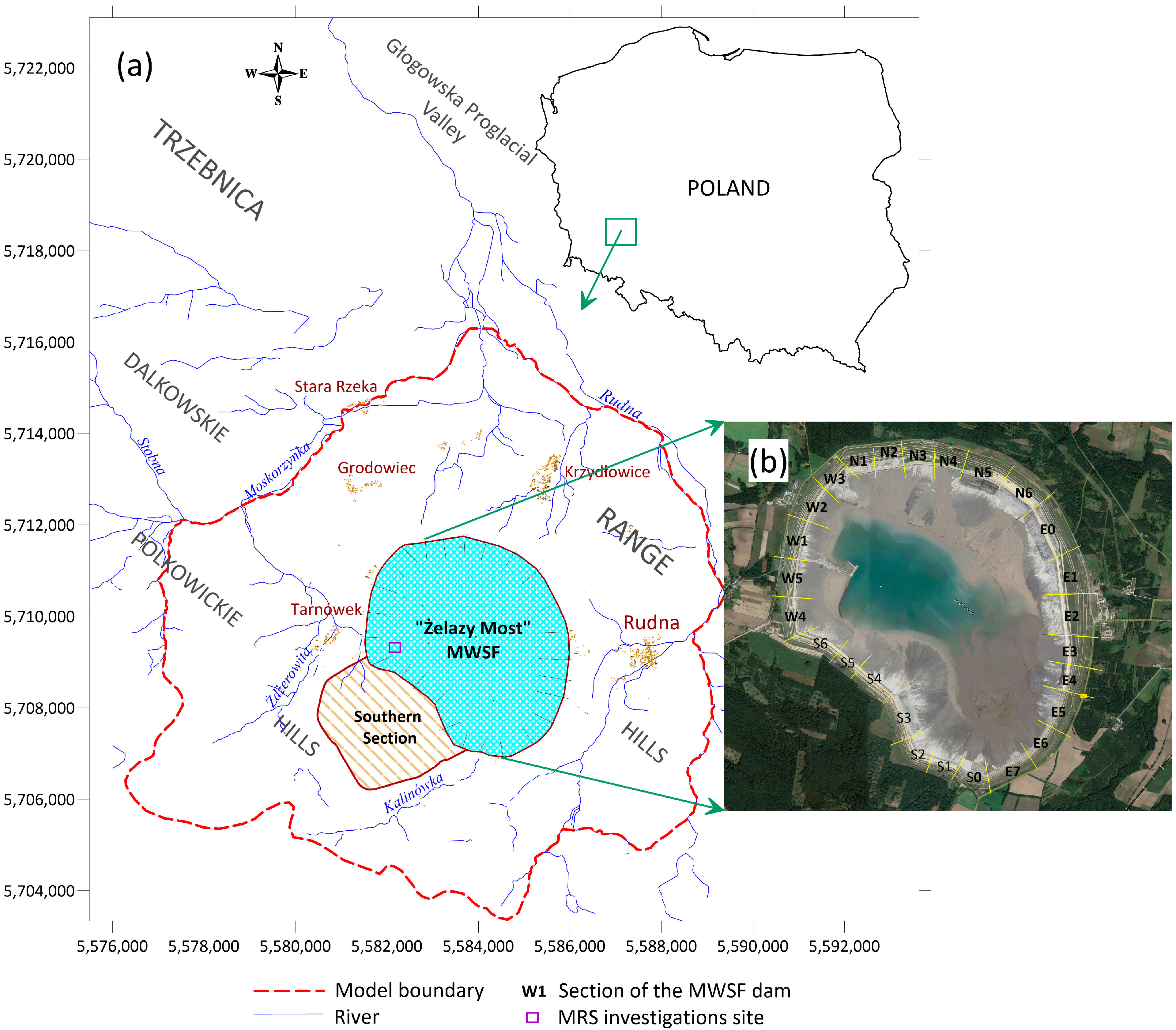



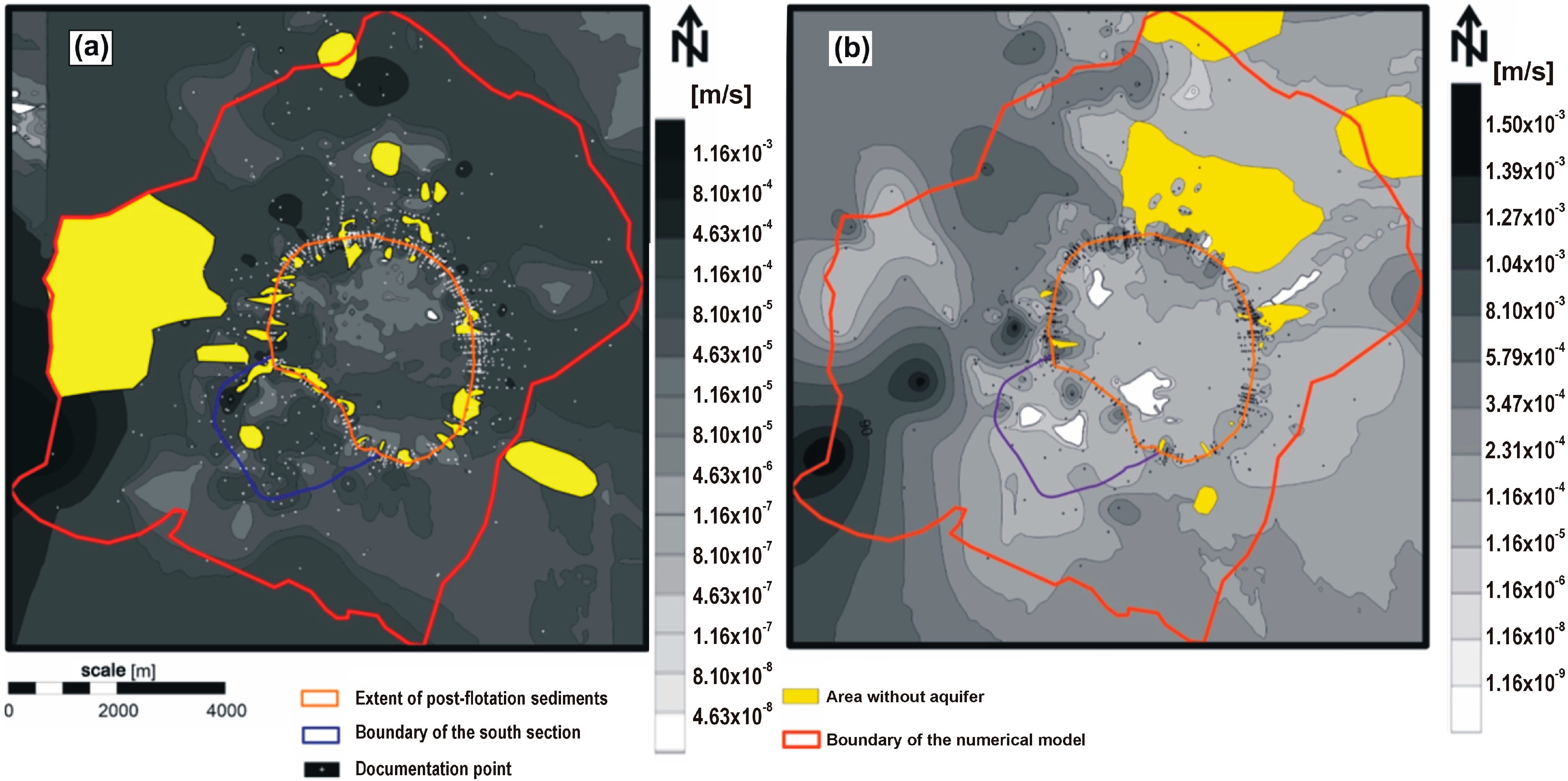
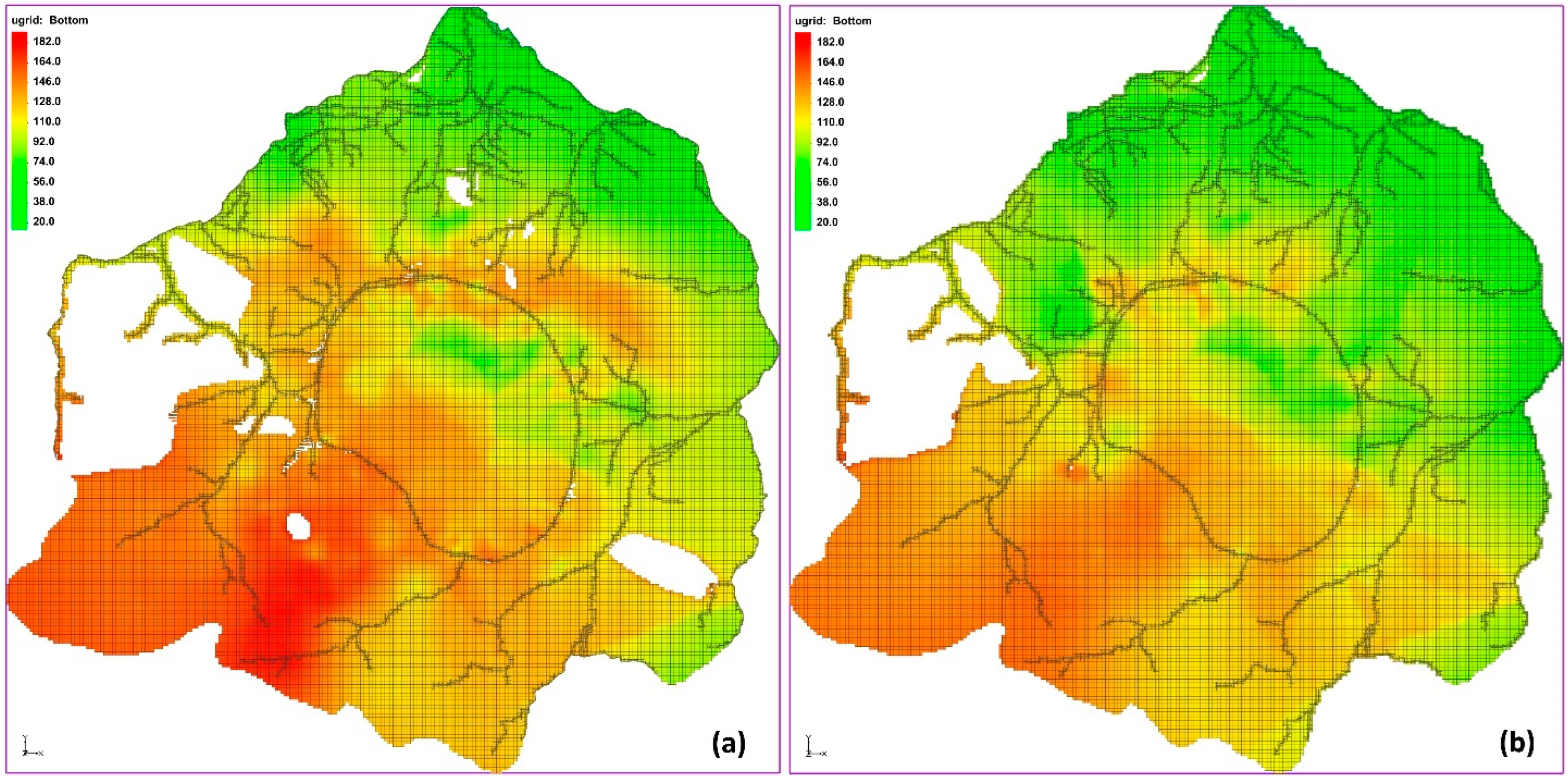
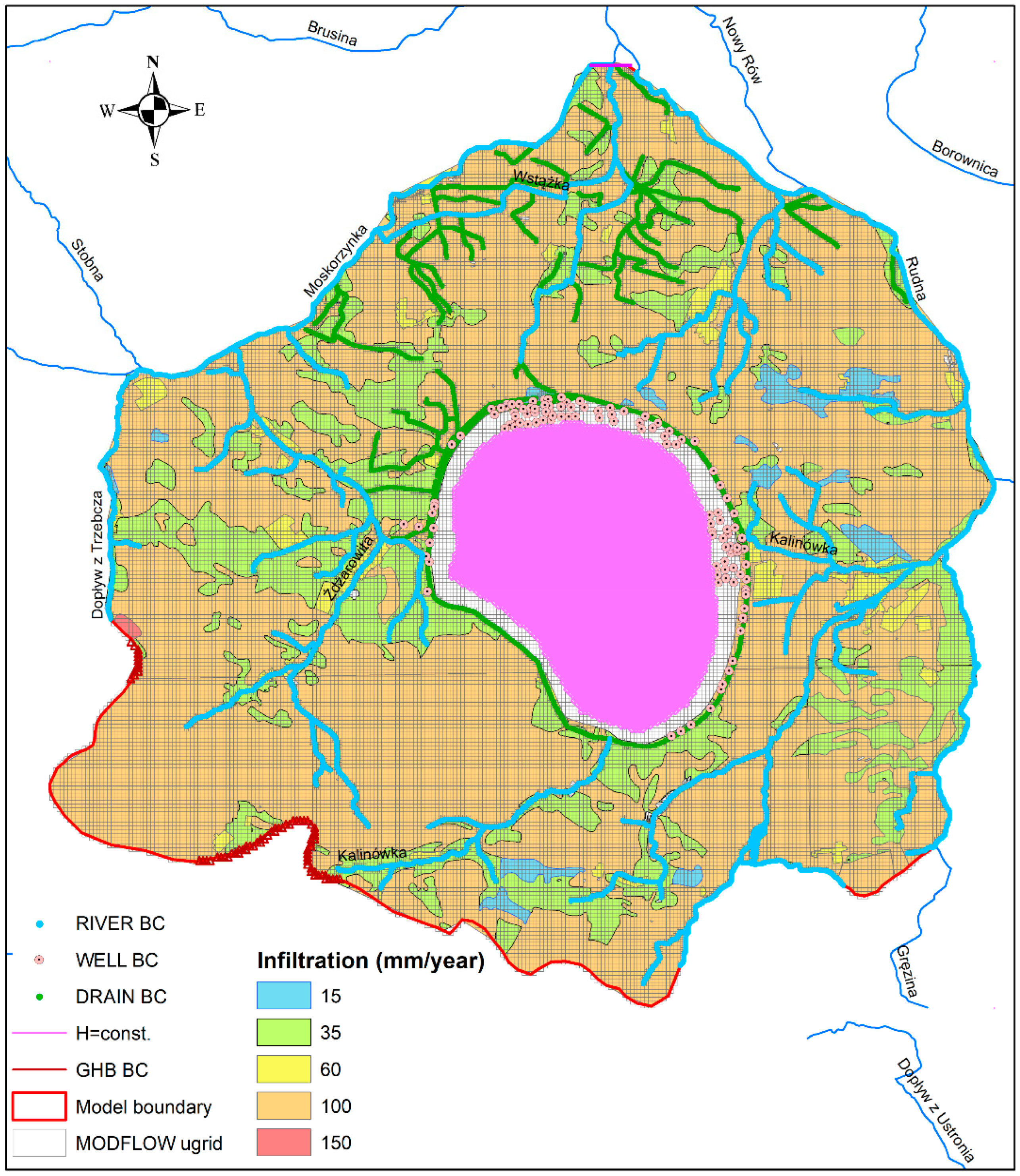
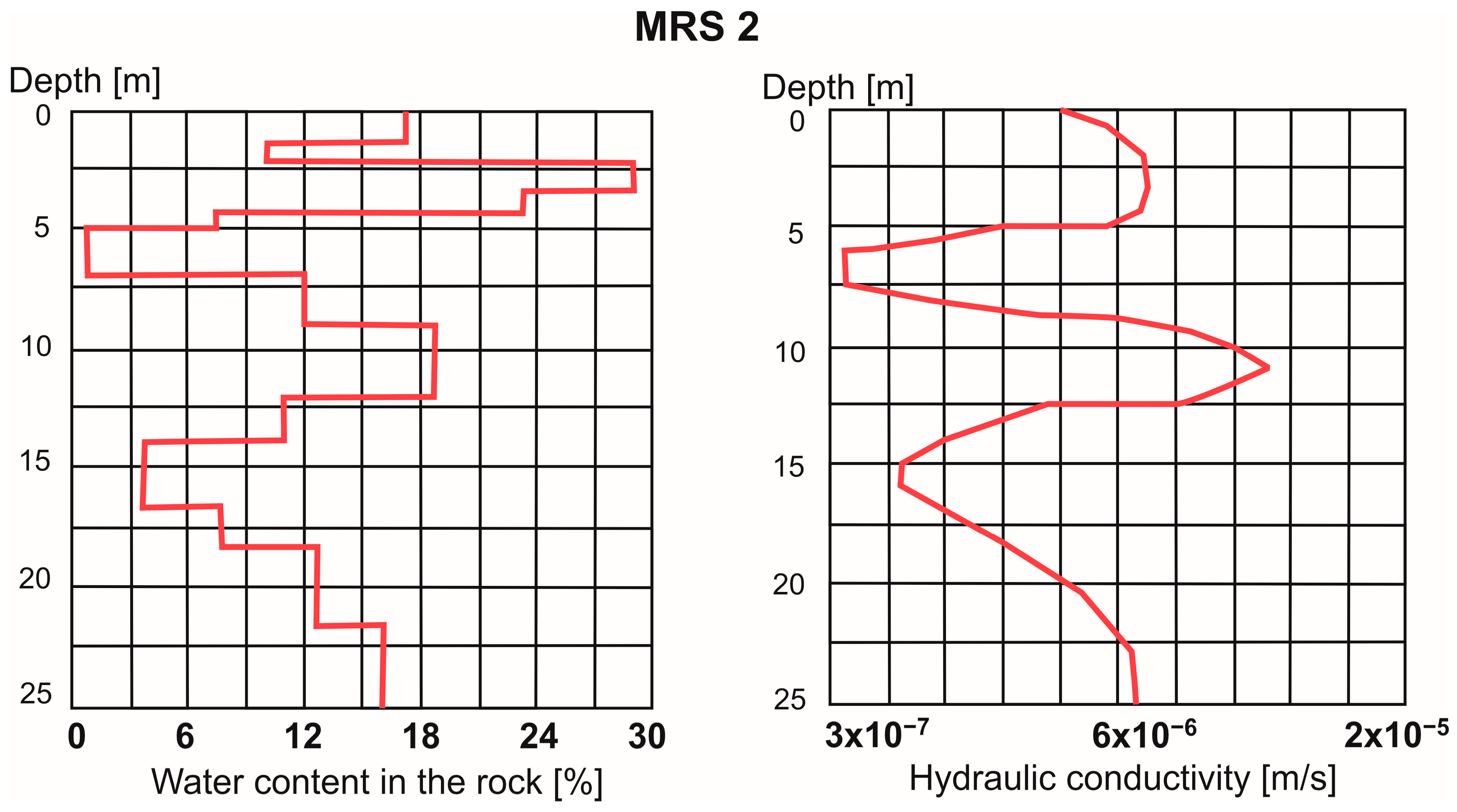

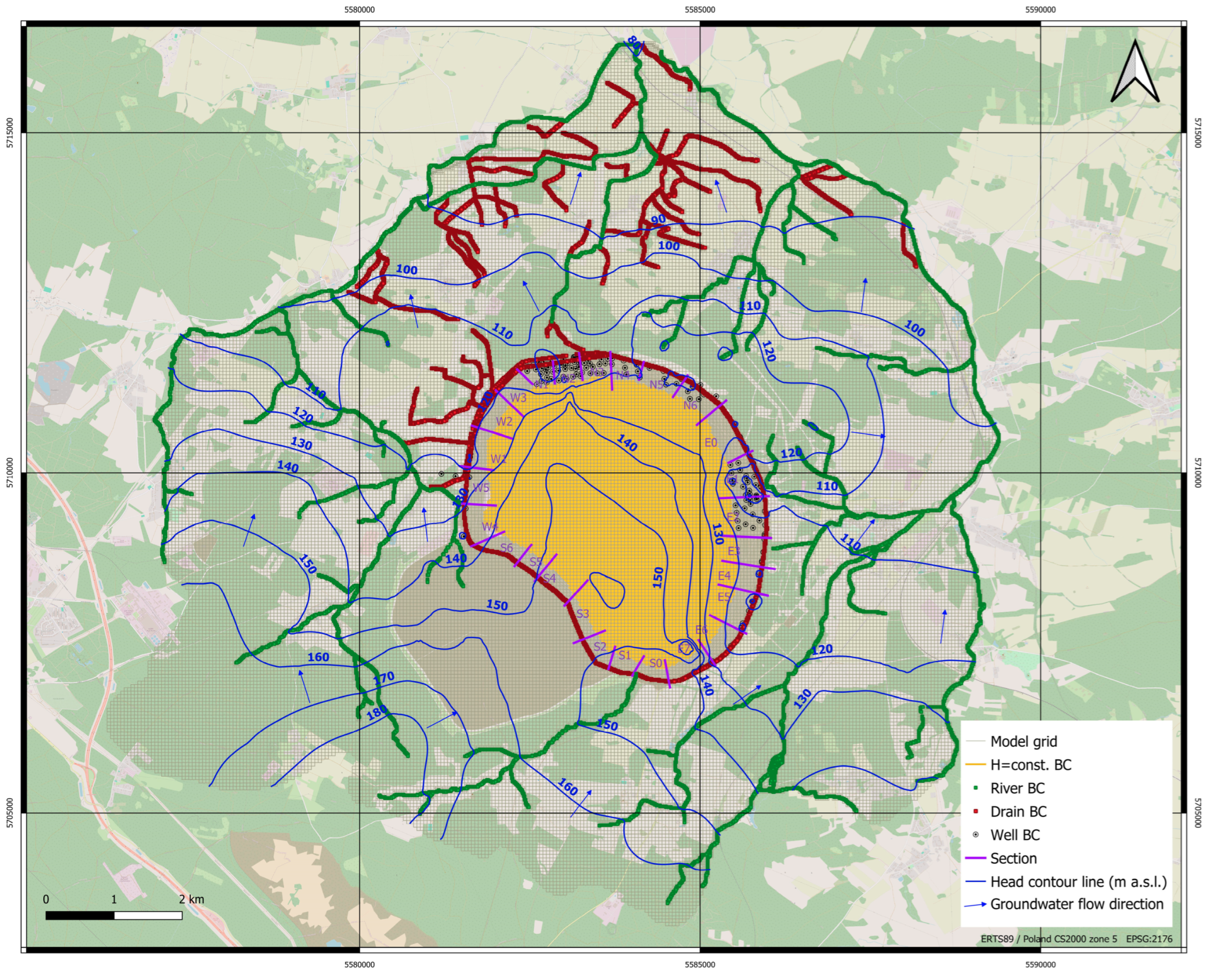

| Section | Dam Foot Drainage, Supporting and Additional—2019 (m3/d) | Annular Drainage—2019 (m3/d) | Trenches (m3/d) | Sum (m3/d) | Simulated on the Model (m3/d) |
|---|---|---|---|---|---|
| S0 | 3 | 812 | 140 | 6850 | 6751 |
| S1 | 559 | 812 | 140 | ||
| S2 | 0 | 812 | 140 | ||
| S3 | 0 | 812 | 140 | ||
| S4 | 0 | 812 | 140 | ||
| S5 | 0 | 611 | 140 | ||
| S6 | 0 | 638 | 140 | ||
| W1 | 59 | 485 | 107 | 3468 | 3654 |
| W2 | 7 | 943 | 107 | ||
| W3 | 0 | 459 | 107 | ||
| W4 | 280 | 313 | 107 | ||
| W5 | 8 | 382 | 107 | ||
| N1 | 0 | 424 | 0 | 2879 | 2528 |
| N2 | 0 | 424 | 0 | ||
| N3 | 108 | 296 | 0 | ||
| N4 | 0 | 296 | 0 | ||
| N5 | 36 | 795 | 0 | ||
| N6 | 0 | 499 | 0 | ||
| E0 | 291 | 330 | 250 | 6860 | 6533 |
| E1 | 0 | 696 | 250 | ||
| E2 | 0 | 794 | 250 | ||
| E3 | 0 | 428 | 250 | ||
| E4 | 37 | 942 | 250 | ||
| E5 | 14 | 753 | 250 | ||
| E6 | 23 | 239 | 250 | ||
| E7 | 55 | 261 | 250 | ||
| SUM | 1480 | 15,067 | 3509 | 20,056 | 19,466 |
Disclaimer/Publisher’s Note: The statements, opinions and data contained in all publications are solely those of the individual author(s) and contributor(s) and not of MDPI and/or the editor(s). MDPI and/or the editor(s) disclaim responsibility for any injury to people or property resulting from any ideas, methods, instructions or products referred to in the content. |
© 2024 by the authors. Licensee MDPI, Basel, Switzerland. This article is an open access article distributed under the terms and conditions of the Creative Commons Attribution (CC BY) license (https://creativecommons.org/licenses/by/4.0/).
Share and Cite
Gurwin, J.; Wcisło, M.; Staśko, S.; Buczyński, S.; Modelska, M.; Olichwer, T.; Tarka, R. Hydrodynamic Model of the Area of the Żelazny Most Mining Waste Storage Facility to Reconstruct the Migration of Saline Groundwater. Water 2024, 16, 2431. https://doi.org/10.3390/w16172431
Gurwin J, Wcisło M, Staśko S, Buczyński S, Modelska M, Olichwer T, Tarka R. Hydrodynamic Model of the Area of the Żelazny Most Mining Waste Storage Facility to Reconstruct the Migration of Saline Groundwater. Water. 2024; 16(17):2431. https://doi.org/10.3390/w16172431
Chicago/Turabian StyleGurwin, Jacek, Marek Wcisło, Stanisław Staśko, Sebastian Buczyński, Magdalena Modelska, Tomasz Olichwer, and Robert Tarka. 2024. "Hydrodynamic Model of the Area of the Żelazny Most Mining Waste Storage Facility to Reconstruct the Migration of Saline Groundwater" Water 16, no. 17: 2431. https://doi.org/10.3390/w16172431






